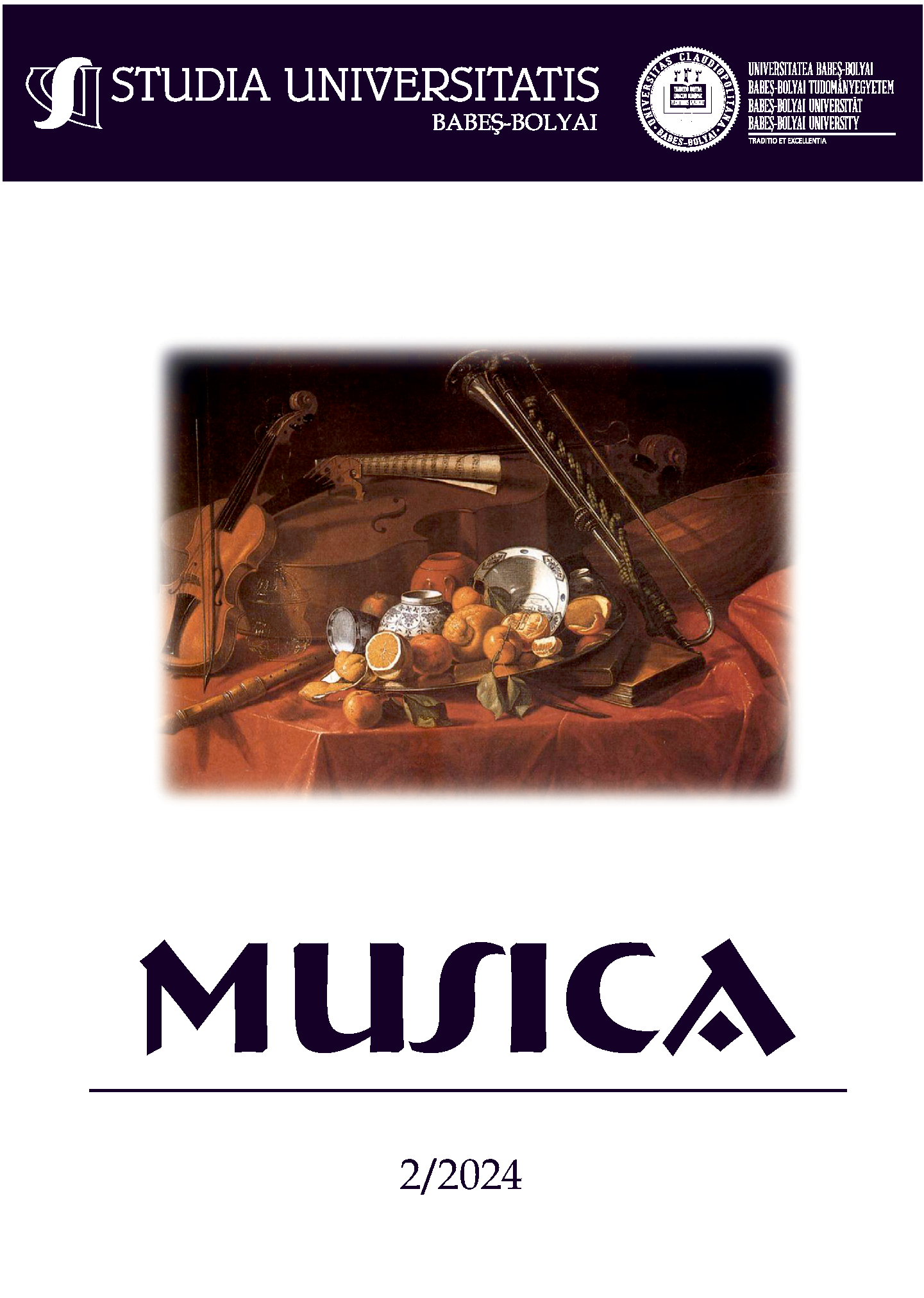Musical Performance in the Context of the Development of Contemporary Musical Art
DOI:
https://doi.org/10.24193/subbmusica.2024.2.10Keywords:
genre and style constants, musical stylisation, musical image, vocal performance, instrumental performance, performance techniqueAbstract
The study aims to determine the specifics of musical performance in the context of the development of contemporary music, considering various musical genres. The methods of analysis, comparison, calculation of the Cronbach's coefficient, and Fisher criterion were used to achieve this goal. It has been established that the most characteristic elements of classical music are an academic approach to interpretation and the embodiment of artistic and aesthetic components. It has been proven that the characteristic features of contemporary music performance are improvisation (α=0.837), emotional expressiveness (α=00.823), and non-standard note combinations (0.819). The practical significance of the work lies in the possibility of using the established features of musical genres for their qualitative interpretation during the educational process.
References
Barabash, Olena, and Weigang, Ganna. “Mathematical Modeling of the Summarizing Index for the Biosystems Status as a Tool to Control the Functioning of the Environmental Management System at Business Entities.” In Mathematical Modeling and Simulation of Systems (MODS'2020). Ed: Shkarlet, S., Morozov, A., Palagin, A. Cham: Springer, 2021, pp. 56-66. http://dx.doi.org/10.1007/978-3-030-58124-4_6
Batovska, Olena, Grebenuk, Natalia, and Byelik-Zolotaryova, Nataliya, Ivanova, Yuliia, Sukhomlinova, Tetiana, and Kaushnian, Iana. “Traditions and Innovations in Contemporary Vocal and Choral Art.” In Studia Ubb Musica, LXVII, 2, 2022, pp. 73-98. https://doi.org/10.24193/subbmusica.2022.spiss2.06
Bechtold, Toni A., Kilchenmann, Lorenz, Curry, Ben, and Witek, Maria A. G. “Understanding the Relationship Between Catchiness and Groove: A Qualitative Study with Popular Music Creators.” In Music Perception, 40, 5, 2023, pp. 353-372. https://doi.org/10.1525/mp.2023.40.5.353
Chaffin, Roger, Ginsborg, Jane, Dixon, James, and Demos, Alexander P. “Recovery from Memory Failure when Recalling a Memorized Performance: The role of Musical Structure and Performance Cues.” In Musicae Scientiae, 27, 1, 2023, pp. 94-116. https://doi.org/10.1177/10298649211025491
Diachenko Iurii, Ovchar, Oleksandr, Dubka, Oleksandr, Pastukhov, Oleksandr, Duve, Khrystyna, and Kostiuk, Dmytro. “Psychological and Pedagogical Study of Neurotic Reactions of Higher Education Students During the Implementation of the form of Control”. In International Journal of Computer Science and Network Security, 21, 11, 2021, pp. 151-156. http://paper.ijcsns.org/07_book/202111/20211120.pdf (date of access 25.08.2024)
Gerstgrasser, S., Vigl, J., and Zentner, M. “The Role of Listener Features in Musical Emotion Induction: The Contributions of Musical Expertise, Personality Dispositions, and Mood State.” In Psychology of Aesthetics, Creativity, and the Arts, 17, 2, 2023, pp. 211-224. https://doi.org/10.1037/aca0000468
Levytska, Oksana, Lystvak, Halyna, Vasiuta, Svitlana, and Zelinska, Nadiia. “The Market of Ukrainian Printed Books with Augmented Reality: Assortment, Problems and Communicative Aspects.” In CEUR Workshop Proceedings, 3296, 2023, pp. 128-140. https://ceur-ws.org/Vol-3296/paper10.pdf (date of access 25.08.2024)
Li, Yang, and Sun, Ruoran. “Innovations of Music and Aesthetic Education Courses Using Intelligent Technologies.” In Education and Information Technologies, 28, 2023, pp. 13665-13688. https://doi.org/10.1007/s10639-023-11624-9
Liu, Xueli, and Shao, Xin. “Modern Mobile Learning Technologies in Online Piano Education: Online Educational Course Design and Impact on Learning.” In Interactive Learning Environments, 32, 4, 2024, pp. 1279-1290. https://doi.org/10.1080/10494820.2022.2118787
Lonergan, Patrick. Theatre and Social Media: Revised Edition. London: Bloomsbury Publishing, 2024. https://www.bloomsbury.com/uk/theatre-and-social-media-9781350464957/ (date of access 25.08.2024)
Odusanya, Oluseun Sunday, and Idọlọr, Emurobome G. “Adapting Apala Music Performance Techniques to Conducting Yoruba Art Choral Works.” In Central Asian Journal of Arts and Design, 4, 11, 2023, pp. 1-14. https://cajad.centralasianstudies.org/index.php/CAJAD/article/view/433 (date of access 25.08.2024)
Padilla, J. M. F. “The Early Music, Beyond the Score.” In Itamar, 2024, 10, 2024, pp. 324-331.
Rexhepi, Flutura Gagica, Breznica, Rreze Kryeziu, Luzha, Besa, and Mehmedi, Lulzim. “Multimedia Tools Integration in the Musical Education Teaching Process.” In Scientific Herald of Uzhhorod University. Series Physics, 55, 2024, pp. 2855-2864. https://doi.org/10.54919/physics/55.2024.285wo5
Shevchenko, Liliia, Mogylevska, Iryna M., Chuprina, Nataliia, Hodina, Inna, and Rusiaieva, Maryna. “Theoretical and Practical Foundations of Concert and Performance Activity.” In Música Hodie, 23. 2023. https://doi.org/10.5216/mh.v23.75286
Thompson, Marc R., Mendoza, Juan Ignacio, Luck, Geoff, and Vuoskoski, Jonna K. “Relationships Between Audio and Movement Features, and Perceived Emotions in Musical Performance.” In Music and Science, 6, 2023. https://doi.org/10.1177/20592043231177871
Utz, Christian. “Reimagining Formal Functions in Post-Tonal Music: Temporality in the Semanticized Form of Salvatore Sciarrino.” In Music Theory Online, 29, 4, 2023. https://doi.org/10.30535/mto.29.4.7
Wald-Fuhrmann, Melanie, O'Neill, Katherine, Weining, Christian, Egermann, Hauke, and Tröndle, Martin. “The Influence of Formats and Preferences on the Aesthetic Experience of Classical Music Concert Streams.” In Psychology of Aesthetics, Creativity, and the Arts, 2023. https://doi.org/10.1037/aca0000560
Wang, Xueyan, Soshi, Takahiro, Yamashita, Masatoshi, Kakihara Marcelo, Tsutsumi, Takanobu, Iwasaki, Shoko, and Sekiyama, Kaoru. “Effects of a 10-Week Musical Instrument Training on Cognitive Function in Healthy Older Adults: Implications for Desirable Tests and Period of Training.” In Frontiers in Aging Neuroscience, 15, 2023, art. 1180259. https://doi.org/10.3389/fnagi.2023.1180259
Wu, Feng, and Wu, Haiqing. “Application of Emotion Recognition Technology Based on Support Vector Machine Algorithm in Interactive Music Visualization System.” In Learning and Analytics in Intelligent Systems, 33, 2023, pp. 515-524. https://doi.org/10.1007/978-3-031-38651-0_51
Yan, Jie, and Hu, Mingzhao. “Emotional Characterization Mining in Music Performance and Its Guiding Role.” In Applied Mathematics and Nonlinear Sciences, 9, 1, art. 20241325. https://doi.org/10.2478/amns-2024-1325
Yao, Bing, and Li, Weiwei. “The Role of a Teacher in Modern Music Education: Can a Student Learn Music with the Help of Modernized Online Educational Technologies Without Teachers?” In Education and Information Technologies, 28, 2023, pp. 14595-14610, https://doi.org/10.1007/s10639-023-11786-6
Downloads
Published
How to Cite
Issue
Section
License
Copyright (c) 2024 Studia Universitatis Babeș-Bolyai Musica

This work is licensed under a Creative Commons Attribution-NonCommercial-NoDerivatives 4.0 International License.



